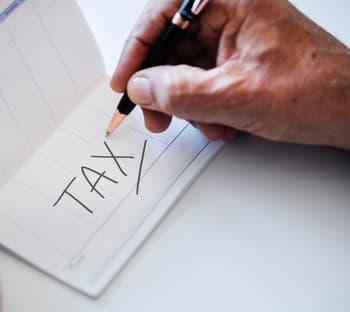As a self-employed business owner, a key decision you need to make concerns which business structure to operate your business through. You can choose from various structures, though two common ones are operating as a sole trader or a private company. The business structure you choose will also determine the tax you must pay. This article explains your tax obligations when operating your business as a sole trader or company.
Taxation as a Sole Trader
As a sole trader, you are taxed at the individual marginal income tax rates. You must report any income your business makes on your personal income statement at the end of each financial year. Your business’ income is reported alongside any other income you make in a financial year outside of your business. Therefore, the amount of tax you pay will depend on:
- the revenue you make from your business;
- additional income sources (i.e. rent from investment properties, dividends from shares you own etc); and
- any deductions you can claim to offset your taxable income.
If you operate your business as a sole trader and your revenue is high, you may pay a higher tax than you would if you operate through a company.
The individual rates can change from year to year, but below you can find the current Australian Resident tax rates for the year 2023/24:
| Taxable income | Tax on this income |
| 0 – $18,200 | Nil |
| $18,201 – $45,000 | 19c for each $1 over $18,200 |
| $45,001 – $120,000 | $5,092 plus 32.5c for each $1 over $45,000 |
| $120,001 – $180,000 | $29,467 plus 37c for each $1 over $90,000 |
| $180,001 and over | $51,667 plus 45c for each $1 over $180,000 |
Taxation as a Company
A company is a separate legal entity. This means the company can:
- enter into contracts;
- own assets;
- sue; and
- be sued in its own name as opposed to your name.
If operating through a company, you must report any revenue your business earns on a tax return in the company’s name, not your individual tax return.
There are two different company income tax rates:
- the ‘base rate entity’ tax of 25%; or
- 30% for all other companies.
Unlike a sole trader, any losses your company has cannot offset your personal income. The company’s tax losses are contained within the company. However, a flat tax rate is appealing to fast-growing businesses as the tax rate remains steady despite revenue growth.
A company is a ‘base rate entity’ if:
- the company’s aggregated turnover for that income year is less than $50 million for that income year; and
- it has 80% or less of its assessable income in that income year that is base rate entity passive income.
For example, Company A has an aggregated turnover under $50 million. Its assessable income is $104,000, comprising of:
- $100,000 revenue from the operation of a business; and
- $4,000 of interest income.
The interest income is base rate entity passive income. Because this income is only 3.8% of its total assessable income, Company A is a base rate entity for the income year, and the 25% company tax rate applies.
Continue reading this article below the formTax Liability as a Shareholder
If your business is a company, you can distribute company profits to yourself as a shareholder by issuing dividends. Each shareholder that receives a dividend will include the amount received on their personal tax returns.
A company can only pay out dividends from the profits they make. Firstly, your company declares a dividend out of the profits on which income tax has already been paid. Then, the company has the option of passing on (‘imputing’) credits for the tax. That process is called ‘franking’ the distribution.
If your company pays fully franked dividends to you as a shareholder, you will receive franking credits for the tax already paid by the company. Therefore, you do not have to pay tax on the whole dividend as you would have to without the franking credit.
You will only pay tax if your personal tax rate is higher than the company’s tax rate. Otherwise, you will receive a tax refund if your personal tax rate is below the company’s tax rate.
For example, suppose you make $130,000 in a financial year from your regular income, and you receive a dividend of $5,000. You will pay 2.5 cents of tax per dollar of the dividend, meaning the tax you pay on the dividend is $125.
If you make $190,000 in a year and receive the same dividend, you would pay 15 cents per dollar on the dividend. Accordingly, you would pay $750 worth of tax on the dividend.
The above scenarios arise because the company has already paid 30% worth of tax on its income.
Goods and Services Tax (GST)
Registering for Goods and Services Tax (GST) is mandatory for both a company and a sole trader if your business:
- has a turnover of $75,000 or more;
- provide rideshare services for money, such as driving for Uber; or
- want to claim fuel tax credits for your business.
If none of the above applies to your business, it is optional for you to register for GST.
However, if you do fall under these categories, you must account for GST on any invoices that you issue to Australian customers, clients and businesses from the day you become eligible. You will do this by adding a 10% GST charge item.
Notably, if any part of your income involves ride-sharing services, GST registration is compulsory regardless of how much income you are making. If you are self-employed and work another job, only the income you make under self-employment counts towards the $75,000 threshold.
If you do not register for GST, you should closely monitor your turnover. You need to register either before the threshold is reached or within 21 days of this occurring. Otherwise, the ATO may penalise you if your revenue surpasses $75,000 and you fail to register.
Capital Gains Tax Discount for Sole Traders
As a sole trader, you can receive a 50% CGT discount on your capital gain before including it in your income in certain situations. You must have owned the asset for at least 12 months, and are an Australian tax resident.
Capital Gains Tax Discount for Companies
Unlike sole traders, companies cannot access the 50% CGT discount. However, you could access small business CGT concessions if your company is a small business entity.
Your company may be eligible for the small business CGT concessions if:
- the business has an aggregated turnover of less than $2 million; or
- the company has a total net value of assets (including any affiliated entities like subsidiary companies) that does not exceed $6 million.
The small business CGT concessions allow you to disregard some or all of the capital gains made from an active asset.
An active asset is an asset used in the course of carrying on a business or an asset inherently connected with the business. For example, the corner store you bought to sell your candy merchandise could be an ‘active asset’.
If you sell an active asset that has been continuously owned for 15 years, and you are aged 55 or over and retiring, you can disregard the entire capital gain.
If this 15-year exemption is not available, you can:
- reduce the capital gain by 50%;
- use the small business retirement exemption to reduce capital gain for amounts up to $500,000; or
- defer all or part of the capital gain for two years or longer if you acquire a replacement active asset or spent money on making capital improvements on that active asset.
The purpose of these concessions is to boost your cash flow and potentially eliminate tax payable on a business exit.

The LegalVision Startup Manual provides guidance on a number of common challenges faced by startup founders including structuring, raising capital, building a team, dealing with customers and suppliers, and protecting intellectual property.
The guide includes 10 case studies featuring Australia’s top VC fund partners and leading Australian startups.
Personal Services Income
If you are wholly under self-employment, be aware of the rules concerning Personal Services Income (PSI). This is income produced mainly from your personal skills or efforts as an individual.
Your income can fall under PSI in almost any industry or profession. Examples include:
- professionals in the financial industry;
- information technology consultants;
- engineers;
- construction workers; and
- medical practitioners.
If you are self-employed and the ATO classifies your income as PSI, they will tax your business’ profits as a wage to you. Therefore, even if you make money through a company structure, the net outcome is similar to that of a sole trader.
However, the PSI rules are unlikely to apply if you have employees or are selling goods. You can retain any excess profits in the company to be taxed at the company rate.
Key Takeaways
As a self-employed business owner, the business structure you choose to operate through will determine the tax you must pay. Your tax obligations as a sole trader will differ from those of a private company.
If you need help choosing a business structure or navigating your tax considerations as a company, our experienced taxation lawyers can assist as part of our LegalVision membership. For a low monthly fee, you will have unlimited access to lawyers to answer your questions and draft and review your documents. Call us today on 1300 544 755 or visit our membership page.
We appreciate your feedback – your submission has been successfully received.











